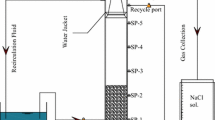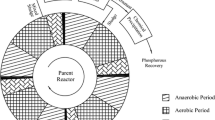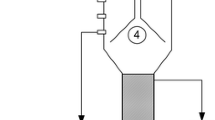Abstract
Biological removal of sulfide, nitrate, and phenol at loading rates of 600 g S/(m3 day), 900 g N/(m3 day), and 450 g C/(m3 day), respectively, from synthetic wastewaters was achieved in an expanded granular sludge bed (EGSB) reactor, whose rates are much higher than literature works and are considered feasible for handling high-strength petrochemical wastewaters without dilution. Effects of C/S ratio (2–2.5:1) on EGSB performance were noted insignificantly. The strains Bacillus sp., Thauera sp., and Pseudomonas sp. were the heterotrophic denitrifiers and the strains Thiobacillus sp., Azoarcus sp., and Sulfurovum sp. were the autotrophic denitrifiers in the EGSB granules. The EGSB reactor experienced biological breakdown at loadings higher than 1200 g S/(m3 day), 1800 g N/(m3 day), and 900 g C/(m3 day) by the following mechanism: high sulfide first inhibits heterotrophic denitrifies (Bacillus sp. and Pseudomonas sp.), thereby accumulating nitrite in the system; then, the accumulated nitrite inhibits autotrophic denitrifiers (Thiobacillus sp., Azoarcus sp., and Sulfurovum sp.) to complete breakdown of the system.




Similar content being viewed by others
References
APHA (2005) Standard Methods for the Examination of Water and Wastewater, 21st edn. American Public Health Association, Washington
Beristain-Cardoso R, Texier AC, Alpuche-Solis A, Gomez J, Razo-Flores E (2009a) Phenol and sulfide oxidation in a denitrifying biofilm reactor and its microbial community analysis. Process Biochem 44(1):23–28
Beristain-Cardoso R, Texier AC, Sierra-Alvarea R, Razo-Flore EJ, Field A, Gomez J (2009b) Effect of initial sulfide concentration on sulfide and phenol oxidation under denitrifying conditions. Chemosphere 74:200–205
Cadena F, Peters RW (1988) Evaluation of chemical oxidizer for hydrogen sulfide control. J Water Pollut Control Fed 60(7):1259–1263
Chen C, Ren NQ, Wang AJ, Yu ZG, Lee DJ (2008) Simultaneous biological removal of sulfur, nitrogen and carbon using EGSB reactor. Appl Microbiol Biotechnol 78:1057–1063
Chen C, Wang A, Ren N, Lee DJ, Lai JY (2009) High-rate denitrifying sulfide removal process in expanded granular sludge bed reactor. Bioresour Technol 100(7):2316–2319
Conner JA, Beitle RR, Duncan K, Kolhatkar R, Sublette KL (2000) Biotreatment of refinery spent-sulfidic caustic using an enrichment culture immobilized in a novel support matrix. Appl Biochem and Biotechnol Part A Enzym Eng Biotechnol 84–86:707–719
Eiroa M, Vilar A, Amor L, Kennes C, Veiga MC (2005) Biodegradation and effect of formaldehyde and phenol on the denitrification process. Water Res 39(2–3):449–455
Huang C, Li Z, Chen F, Liu Q, Zhao Y, Zhou J, Wang A (2015) Microbial community structure and function in response to the shift of sulfide/nitrate loading ratio during the denitrifying sulfide removal process. Bioresour Technol 197(2):227–234
Lee DJ, Wong BT, Adav SS (2013) Azoarcus taiwanensis sp. nov., a denitrifying species isolated from a hot spring. Appl Microbiol Biotechnol 98(3):1–7
Liu B, Mao Y, Bergaust L, Bakken LR, Frostegard A (2013) Strains in the genus Thauera exhibit remarkably different denitrification regulatory phenotypes. Environ Microbiol 15(10):2816–2828
Liu C, Zhao C, Wang A, Guo Y, Lee DJ (2015a) Denitrifying sulfide removal process on high-salinity wastewaters. Appl Microbiol Biotechnol 99(15):6463–6469
Liu C, Zhao D, Yan L, Wang A, Gu Y, Lee DJ (2015b) Elemental sulfur formation and nitrogen removal from wastewaters by autotrophic denitrifiers and anammox bacteria. Bioresour Technol 191(5):332–336
Olmos A, Olguıin P, Fajardo C, Razo-Flores E, Monroy O (2004) Physicochemical characterization of spent caustic from the OXIMER process and source waters from Mexican oil refineries. Energ Fuel 18:302–304
Rezaee A, Godini H, Dehestaniathar S, Yazdanbakhsh A, Mosavi G, Kazemnejad A (2008) Biological denitrification by Pseudomonas stutzeri immobilized on microbial cellulose. World J Microb Biot 24(11):2397–2402
Spence J, Bottrell H, Higgo W, Harrison I, Fallick AE (2001) Denitrification and phenol degradation in a contaminated aquifer. J Contam Hydrol 53(3):305–318
Thomas S, Sarfaraz S, Mishra LC, Iyengar L (2002) Degradation of phenol and henolic compounds by a defined denitrifying bacterial culture. World J Microbiol Biotechnol 8(1):57–63
Truper HG, Schlegel HG (1964) Sulfur metabolism of Thiorhodaceae. I. Quantitative measurements on growing cells of Chromatium okenii. Anton Leeuw Int 30(1):225–238
Verbaendert I, Boon N, Vos PD, Heylen K (2011) Denitrification is a common feature among members of the genus Bacillus. Syst Appl Microbiol 34(5):385–391
Wang A, Du D, Ren N, van Groenestijn JW (2005) An innovative process of simultaneous desulfurization and denitrification by Thiobacillus denitrification. J Environ Sci Health A 40(5):1939–1949
Wu C, Zhou Y, Wang P, Guo S (2015) Improving hydrolysis acidification by limited aeration in the pretreatment of petrochemical wastewater. Bioresour Technol 194(2):256–262
Yang Q, Xiong P, Ding P, Chu L, Wang J (2015) Treatment of petrochemical wastewater by microaerobic hydrolysis and anoxic/oxic processes and analysis of bacterial diversity. Bioresour Technol 196(5):169–175
Acknowledgments
The research was supported by the National Natural Science Foundation of China under Grant No. 21307160 and the Natural Science Foundation of Shandong Province under Grant No. ZR2013EEQ030.
Author information
Authors and Affiliations
Corresponding author
Ethics declarations
This article does not contain any studies with human participants or animals performed by any of the authors.
Conflict of interest
The authors declare that they have no competing interests.
Rights and permissions
About this article
Cite this article
Liu, C., Han, K., Lee, DJ. et al. Simultaneous biological removal of phenol, sulfide, and nitrate using expanded granular sludge bed reactor. Appl Microbiol Biotechnol 100, 4211–4217 (2016). https://doi.org/10.1007/s00253-016-7293-2
Received:
Revised:
Accepted:
Published:
Issue Date:
DOI: https://doi.org/10.1007/s00253-016-7293-2




